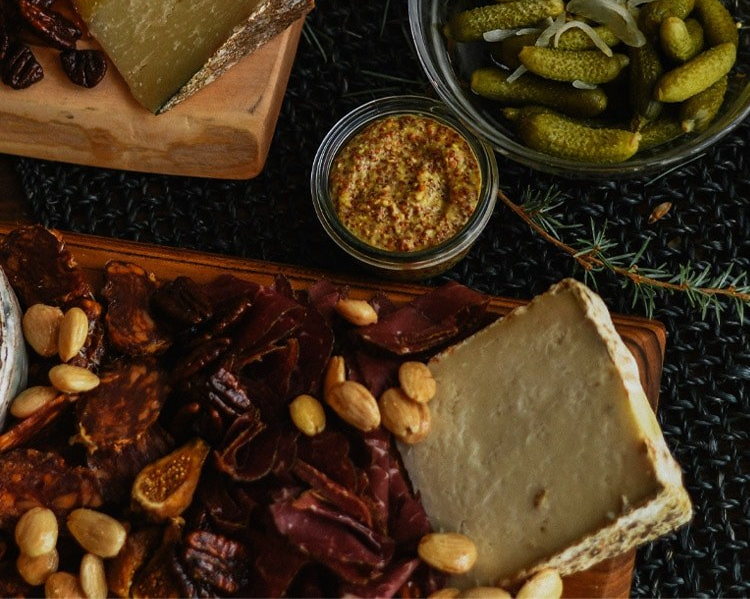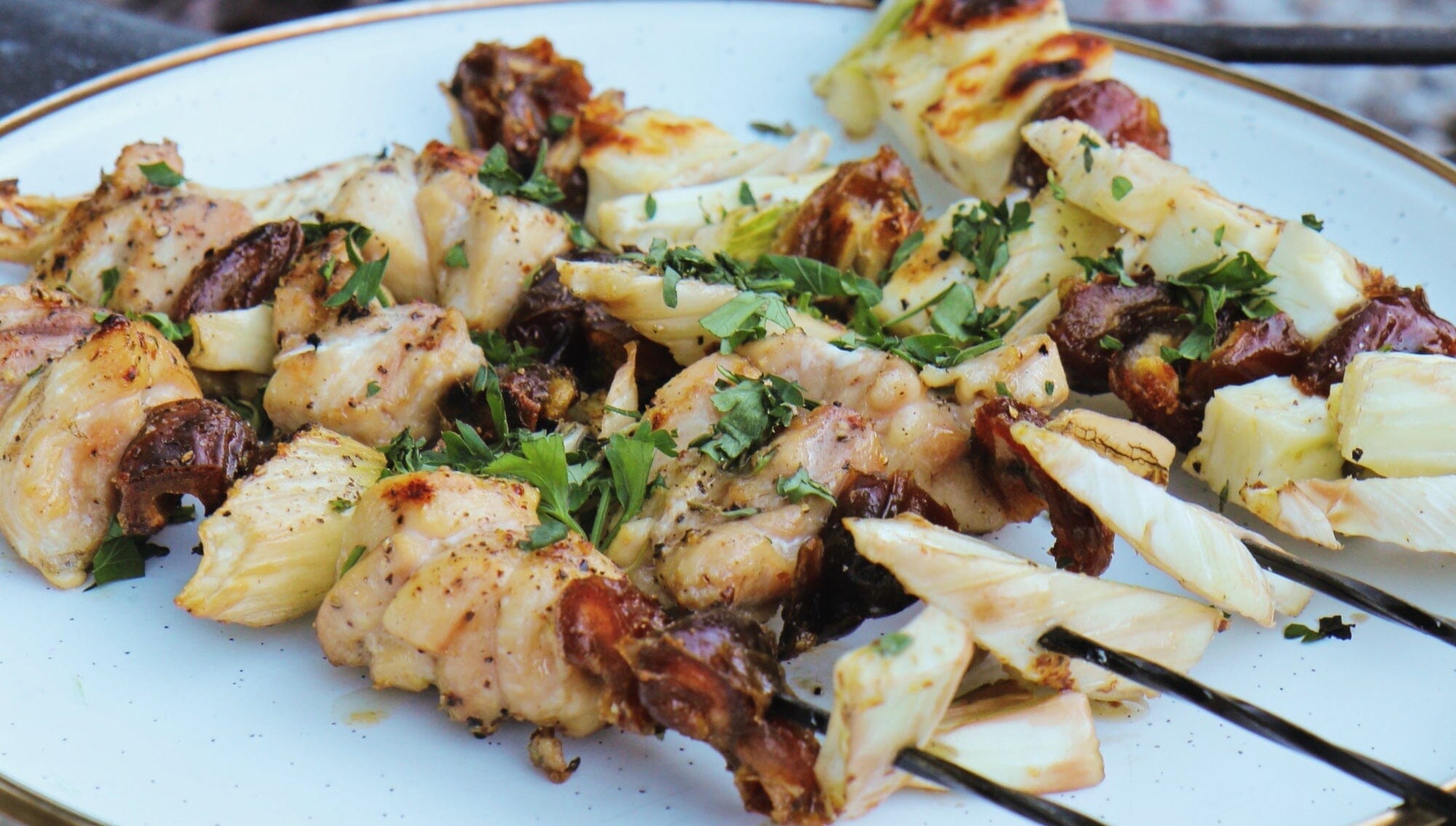When we wanted to learn how to make an impressive cheese board for parties, we turned to specialty foods purveyor Sam Starr. Sam can always be counted on to present a balanced, thoughtful, and delicious array. She walked us through selecting and combining our components, breaking it down into simple rules of thumb that instantly gave us the confidence to volunteer for charcuterie duty. Read on for her guidelines to making a perfect charcuterie board every time.

· · ·
How to Make a Charcuterie Board
What Is A Charcuterie Board?
A charcuterie board is an assembly of meats, cheeses, fruits, nuts, and other snacks. It can be as simple or elaborate as you want. We often start with a simple wooden cutting board, but you can use any platter or large, flat serving dish. As far as tools go, small knives are always a good pick. They work well for both cutting and slicing and spreading jams and jellies. (For an excellent all-in-one knife that also opens your bottles of beer and wine, check out the Provisions Corkscrew Knife.)

· · ·
Charcuterie Board Ideas
Charcuteries Cheeses
There are so many options for cheeses that it can get overwhelming. To make it simple, focus on having variety in textures and milk types. Depending on the size of your board, you should have one each of cow, sheep, and goat options with soft rind, firm, and hard cheeses in the mix. Flavors should range between nutty and mild to funky and unique.
Rule of thumb: 1 cow, 1 sheep, 1 goat; 1 soft, 1 firm, 1 hard.

· · ·
Charcuterie Meat Ideas
When choosing meats for your boards, the colors, flavors, and sizes should all vary. Choose different sizes of meat, such as small and large salamis, then toss whole-muscle cuts into the mix. (Confused about whole-muscle cuts? Stick with cuts of meat shaved from a larger piece of meat, like prosciutto or cured, thin-sliced ham, as opposed to blended meat like salami.) The flavors can be paired with the cheeses or chosen for their unique qualities, but always aim to have something spicy, something smoky, and something unexpected.
Rule of thumb: 1 small salami, 1 large salami, 1 whole-muscle meat.
"When choosing meats and cheeses, variety is the spice of life," Sam advises. You could focus on the meats of one region (Italy, France, Spain, or domestic) or create a spread of your favorites. Try new things, take risks, and offer contrasts.

· · ·
Crackers and Breads
When choosing types of bread or crackers, remember to go for multiple colors and textures. Bread acts as a vehicle for layering dips, cheeses, and meat, creating customizable bites that play to each person’s preference. For instance, consider a thinner, flavor-neutral butter cracker and a more complex, heartier cracker like rye or sourdough. Add a flavored cracker that features herbs, like dill or rosemary, or fruit, like cranberry.
Rule of thumb: 1 type of cracker for each type of cheese you have featured. Ensure they’re contrasting flavors and textures.

· · ·
Finger-Foods
This category encompasses the little miscellaneous snacks that add some extra flavor. Dress up any board with a wide assortment of accompaniments, or keep it simple with just a few of your favorites. Rustic boards call for items spread all over the board with very little structure, whereas a more composed board will have things in individual containers, creating a polished and tidy board. Get creative when selecting accompaniments, but you can't go wrong with Spanish figs, Marcona almonds, honeycomb, caramelized pecans, olives, and cornichons.
Rule of thumb: Variety: salty, sweet, spicy, acidic, savory; pickled, dried, fresh, soft, crunchy.

· · ·
Charcuterie Sauces and Dips
Whether sweet or savory, include a few spreadable additions like honey, jams/jellies, or a hot dip such as the classic spinach and artichoke or this delicious smoked salmon dip. A hot dip is easily prepared in a small cast iron skillet in the oven or stovetop. And no need to transfer the dip to another container: cast iron adds a great rustic touch to your charcuterie board and leaves you with minimal cleanup.
For your spreadables, consider a smaller jar or cup, such as a small espresso cup (available in several colors to match your mood). Add small knives or spoons to make spreading a breeze and to keep the flavors separate.
Rule of thumb: incorporate 1-2 varieties of sweet jam (like cherry and fig) with a savory option, such as pepper jelly or an onion jam. Add in a hot dip if you’re looking to add a little extra coziness.

· · ·
Seasonal Beverages
Wine is the go-to choice for a charcuterie board. Choose a wine that complements your current season, like a chilled Sauvignon Blanc in summertime. In chillier months, consider a full-bodied red, like Merlot. If you’re a wine connoisseur, choose wines that directly complement the cheeses you’re serving.
Another good option for a charcuterie board is cider, particularly in fall: serve it hard or non-alcoholic, mulled or chilled. The crisp, bright flavor of authentic apple cider can mimic a fine wine and goes well with the varying flavors of your board.
Rule of thumb: Offer whatever your guests prefer best - but it’s always a good idea to have a few different beverages, including at least one non-alcoholic option.
A brief note: A lot of people get hung up on quantities. Sam suggests having one ounce of cheese per person and 3-4 slices of each variety of meat per person to ensure everyone gets a taste of each item. If people will be waiting for the main course for an extended period, err on the side of abundance.

· · ·
Vegetarian or Vegan Charcuterie Board
When creating a meat-free charcuterie board, you want substance and options.
If you’re abstaining from meat but still open to other animal products, keep the cheeses and honey and consider adding a can/tin or two of your favorite high-end fish: canned oysters in olive oil, for example, or mild sardines. These replacements can add in a little protein and allow you to customize even further - or add in a hot crab dip. Or, simply swap out imitation meats as you desire.
If you’re going fully vegan, simply swap with imitation meats and cheeses as desired - or simplify the board altogether. A wealth of dried fruits and pickled vegetables will help build the board and take the place of the cheese and meats. Include plenty of accompaniments such as Marcona almonds, caramelized pecans, Pajero figs, cornichons, olives, green peppercorn mustard, and membrillo. Stick with savory vegan spreads like baba ganoush, hummus, or tapenade, as well as your favorite sweet jams and jellies.



